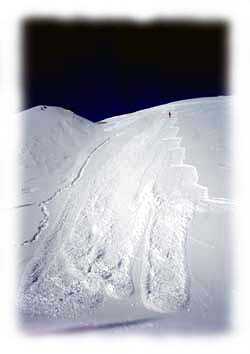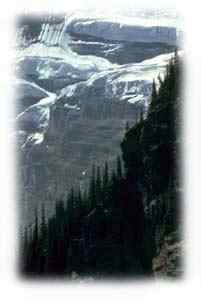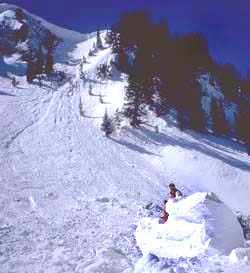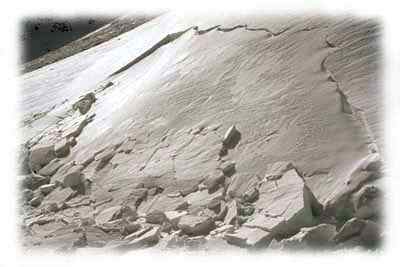

Loose snow avalanche

The loose snow avalanche, or sluff, generally occurs at the surface in new snow or wet spring snow. This type of avalanche often begins at a point and spreads out as it goes. Sluffs seldom contain enough snow to bury a person deeply and the chief danger to winter recreationists from this type of avalanche is from being pushed over a cliff or rock band.

Ice fall avalanches occur when a glacier encounters a steep drop. Chunks of ice "calf" off as the glacier slowly flows downhill under the force of gravity. Ice fall avalanches are unrelated to temperature, time of day or any other factors, despite conventional wisdom to the contrary. The best way to avoid these avalanches is to not travel beneath ice cliffs and through ice falls, or if necessary, roll the dice and travel through quickly.

Roof avalanches
can be deadly for the unwary and will often release as the inside of the house or cabin warms up
Cornice fall avalanches occur when cornices break
loose from the lee side of ridges.
Cornices look like frozen ocean waves stretched along mountain ridges. They form
their characteristic "eaves" of cantilevered snow when prevailing
winds remove snow from slopes on one side of a ridge and deposit it on the other
side of the ridge. The snow that forms cornices is very dense and hard,
yet can be extremely fragile. It is often difficult to determine from the ridge
top where the ground ends and the overhanging cornice is not supported.
This type of avalanche is easily avoided by staying back from the peak of
ridges. These can be deadly as the victim tumbles downhill amid massive, hard and
heavy chunks of snow which often trigger secondary slab avalanches as they pass.
 The most dangerous type of avalanche is the slab avalanche. The slab
is difficult to see and avoid and will often allow a person to travel well out
onto it before failing. This type of avalanche can reah speeds up to 2-300 kmph.
The most dangerous type of avalanche is the slab avalanche. The slab
is difficult to see and avoid and will often allow a person to travel well out
onto it before failing. This type of avalanche can reah speeds up to 2-300 kmph.
Top
Index
Demonstration
Types
Scale Safety
Equipment Links
& Resources
